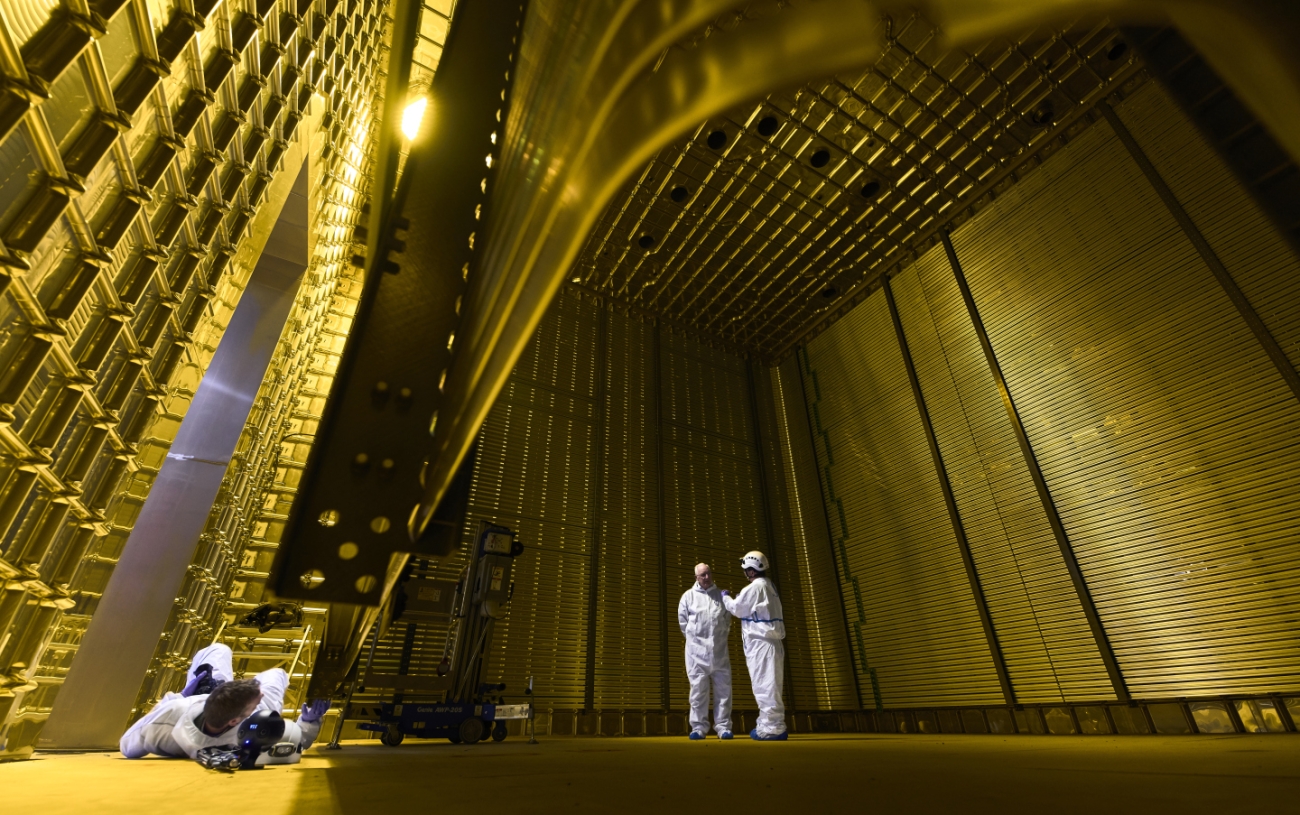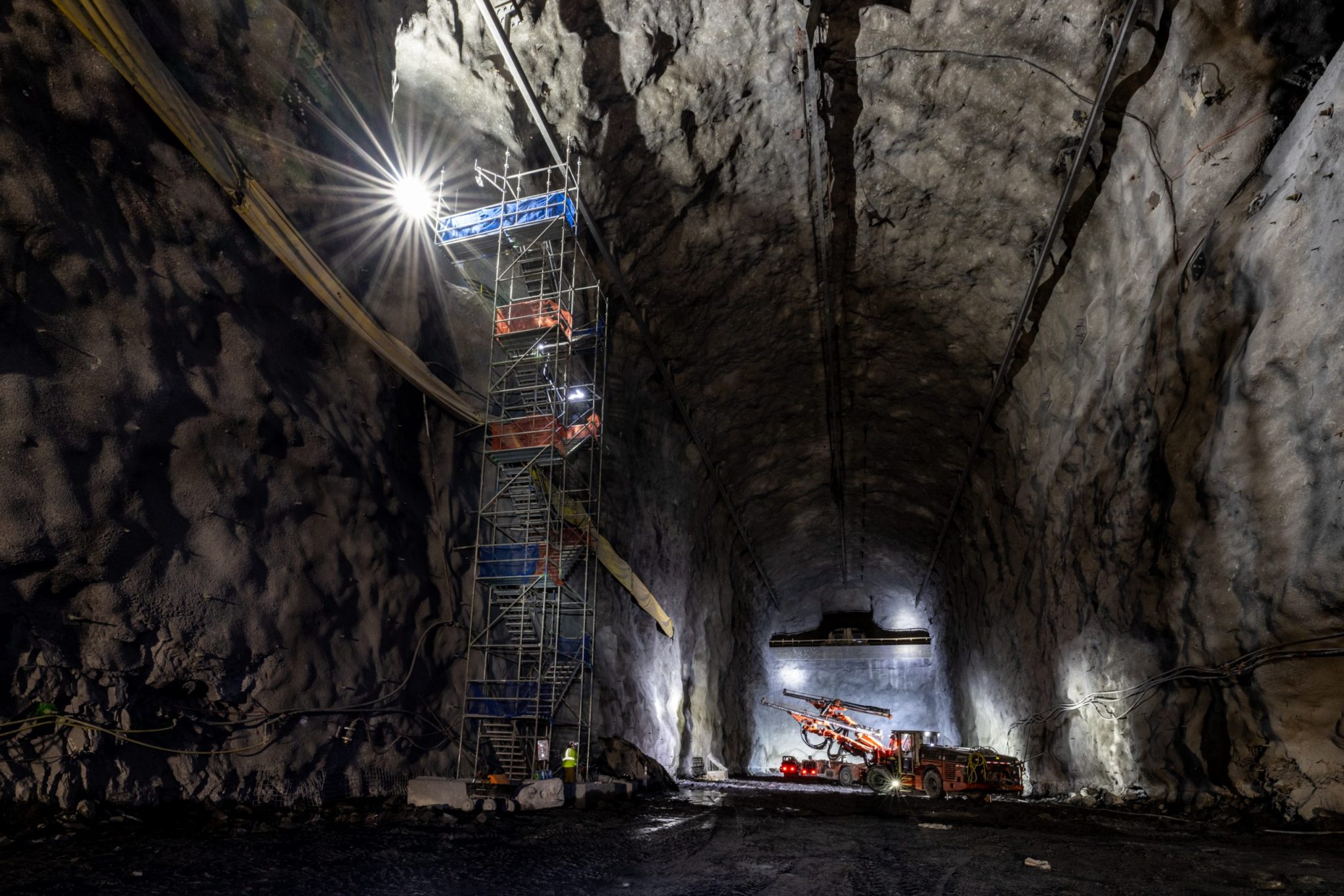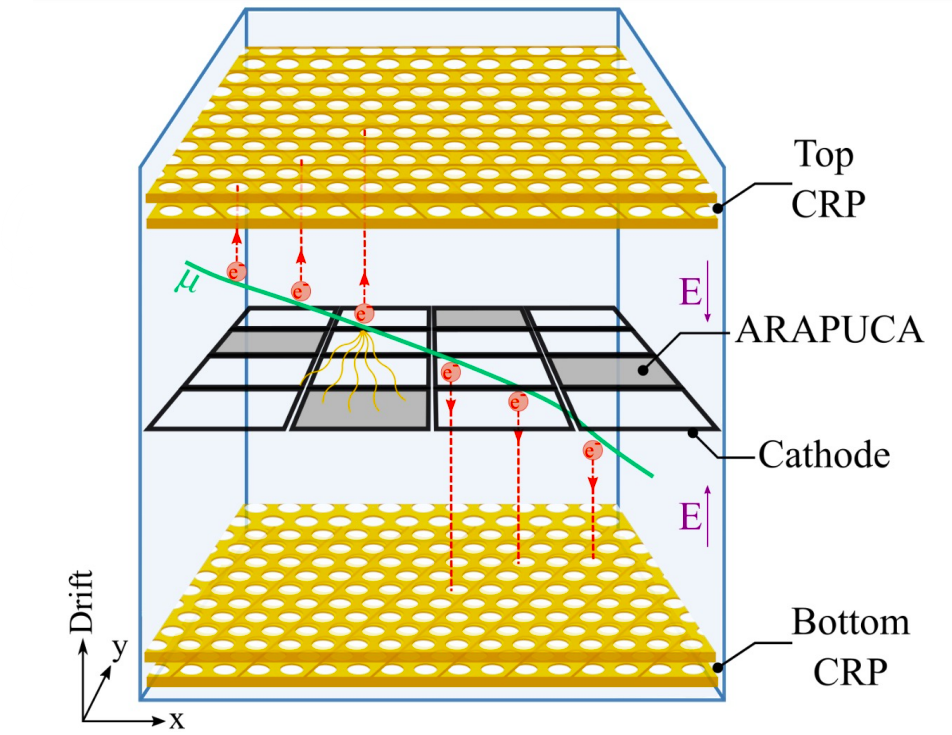ProtoDUNE: Paving the Way for the Deep Underground Neutrino Experiment

The Deep Underground Neutrino Experiment (DUNE) at the Long-Baseline Neutrino Facility (LBNF) is a groundbreaking scientific initiative poised to elucidate the mysteries of neutrinos. Its progress has been marked by remarkable feats of engineering and scientific innovation. In February 2024 LBNF reached a critical milestone with the completion of excavation at the Sanford Underground Research Facility (SURF) in South Dakota. Meanwhile at the CERN Neutrino Platform, ProtoDUNE was being readied for its second run. This article presents these achievements, the contributions of CERN and Fermilab, and the critical role of ProtoDUNE in advancing the project.
Completion of Underground Excavation
In February 2024 the LBNF project completed underground excavation at SURF. During three years, over 800,000 tons of rock were blasted and moved to the surface from a depth of 1,500 meters to create the enormous caverns that will host the 4 DUNE Far Detectors and their services, each detector being 66 meters long, 19 meters wide, and 18 meters high.

Construction workers excavated two massive caverns, each over 500 feet in length and roughly seven stories high, to accommodate the enormous particle detector modules for the Deep Underground Neutrino Experiment, hosted by Fermilab. A third cavern will be dedicated to housing the utilities required for the detector’s operation. Photo credit: Matthew Kapust, Sanford Underground Research Facility.
The Far Detectors
The first three detectors will be 17 kton liquid-argon time-projection chambers (LArTPCs), while the design of the fourth detector, the Module of Opportunity, will be decided, among multiple ongoing R&Ds, at a later stage. The Far Detectors, together with the Near Detector at Fermilab, will use the intense neutrino beam produced from PIP-II protons to determine the neutrino mass ordering, search for CP Violation, and overconstrain the three-family neutrino mixing paradigm searching for evidence of new physics. The first two detectors will be taking data by the end of this decade.
Advancing Cryostat Technology
CERN is providing two far detector cryostats as in-kind contribution to LBNF/DUNE. They are based on a novel approach inspired by the liquified-natural-gas (LNG) shipping industry and developed at CERN as described in detail in the previous issue of the EP newsletter (Discover How CERN's Innovative Cryostat Technology Advances Neutrino Physics)
This solution has been successfully demonstrated at the kiloton scale in the two ProtoDUNE cryostats, and also for the SBND experiment at Fermilab and the Darkside-20k dark matter experiment at Gran Sasso. At the time of writing, the steel structure for the second far detector vessel is nearing construction in Spain for transportation to the USA later this year. Underground assembly of cryostats at SURF will start less than a year from now.
Proto-DUNE: A Successful Precursor
ProtoDUNE (NP04) was constructed at CERN in 2016-2018 and took data in 2018-2020. It successfully demonstrated CERN’s novel cryostat technology and the design of the DUNE Far Detector TPC and all its elements (Anode Plane Arrays, High Voltage System, Cold Electronics, Photon Detector System etc) for the first time at the kiloton scale. It is the LAr TPC with the longest drift distance (3.6m) and the largest contiguous drift volumes (each one 155.5m3) made to this day. It has been a resounding success, meeting or exceeding all the performance requirements of DUNE, with 7 journal publications and around 15 PhDs so far using its data.

ProtoDUNE HD Successfully Filled with Liquid Argon (LAr)
Iterating on Success: New Components and Improvements
Building on the experience gained from ProtoDUNE, the DUNE collaboration has introduced several key improvements to critical components for the full-scale experiment. New chips that operate in the liquid argon were developed, and now the Cold Electronics boast 14 bits instead of 12. The High Voltage system was modified to mitigate occasional discharges and also to be easier to manufacture and install. The Anode Planes were modified to meet the far detector mechanical requirements. The Photon Detector System is entirely new, based on the X-Arapuca concept and with new bespoke electronics. To better monitor and calibrate the detector, two ionization laser systems were developed which can scan the TPC active volume with light tracks to monitor and correct for electric field distortions from space charge effects. Two Bi-207 sources were installed inside the TPC to provide additional calibration reference points, and the argon purity monitors and the temperature sensors were upgraded. The DAQ system also had a major upgrade and is now an application of the design that will be deployed in the DUNE far detectors, and trigger primitives formed from wires-above-threshold in the TPC in real time are implemented to enable self-trigger (in addition to beam-trigger) operation.

The Coldbox is a small TPC collecting cosmics data to test CRP and X-ARAPUCA instrumentation.

With exceptionally low electronic noise, ProtoDUNE VD is equipped with 2 top CRPs and 2 bottom CRPs (compared to the 2 x 80 CRPs planned for the full DUNE far detector). It boasts a 2x3m drift distance, while the full detector will feature a 2x6m drift. Beam and cosmic data collection is scheduled for late 2024-25, utilizing argon sourced from ProtoDUNE HD.
Finally, a significant change from the original ProtoDUNE run is that in the current run data are taken with both positive and negative particles. This allows the pion, proton, and kaon cross-sections on argon to be measured more precisely and in some cases for the very first time. These measurements are part of the integral DUNE physics program.
A very successful ProtoDUNE II run
The new TPC was assembled inside the cryostat in 2022. The cryostat was filled with argon in early 2024 and all systems were commissioned and optimized for data in May. The dedicated H4-VLE beamline was commissioned after 5 years of inactivity. To maintain the ultra-low levels of electronegative impurities required for long electron drift, the argon is recirculated continuously through special filters. Beautiful events appeared in the TPC with first beam on June 19. The ProtoDUNE II (NP04)10-week beam running ends on September 16 with about 30 million beam triggers collected at energies between 1 and 7 GeV with both polarities.
All systems operate exceptionally well. The new High Voltage system is stable at 180 kV (TPC drift field 500 V/cm) and no streamer events have been observed. After the beam run, it will be stress-tested by raising the voltage in steps up to a maximum of 300 kV. The new Cold Electronics achieve signal/noise ratios at least as good as the initial ones, and with more bits a wider dynamic range can be covered with the same resolution. The new Photon Detector system also works well, with light efficiency more than an order of magnitude above the old one. The ionization laser system has been tuned, aligned and used to scan the TPC active volume with its “laser tracks”. The DAQ team achieved the seamless integration of all subsystems (TPC, PDS, Laser, Cosmic Ray Tagger) providing ProtoDUNE shifters with a straightforward, dependable system usually found in mature experiments. Around 5 PB of data has been recorded and shipped to Fermilab through the CERN central computing infrastructure.
The stability of the experiment, including the DAQ, has also been a major success. ProtoDUNE has demonstrated exceptional performance, running continuously for up to 40 hours and recording as many as 2 million triggers without interruption. This level of stability is impressive for a prototype and bodes well for the long-term success of the full DUNE experiment.

The image shows a 5 GeV beam with multiple particles captured in a 3 msec readout window. The green arrow indicates a beam particle traversing the first half of the TPC without interaction. Below, electromagnetic activity from an electron, which entered the TPC earlier in the beam spill, has drifted towards the anode. The particle at the bottom, likely a kaon interacting with a nucleus, entered the TPC even earlier, resulting in a greater drift.
Towards the Next Frontier in Neutrino Physics
The journey of ProtoDUNE has been instrumental in shaping the future of the Deep Underground Neutrino Experiment. Together with the excavation of massive underground caverns, the development of state-of-the-art cryostats, and the improved detector systems, ProtoDUNE has laid the groundwork for one of the most ambitious experiments in neutrino physics. The second phase of ProtoDUNE, now nearing completion at the CERN Neutrino Platform, has met its major aim to be the successful “Module 0” for the far detector. It has also collected large data samples that will be analyzed by many of the dedicated early career physicists who filled the more than 500 shift slots required to cover the run. Lessons learned during integration, commissioning, and operations will be valuable for refining the far detector activities underground in South Dakota and propel DUNE toward its goal of unlocking the mysteries of the neutrino and challenging the frontiers of particle physics.
